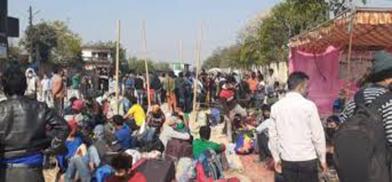Nepalis still stuck in no man’s land
Having lost their jobs, Nepali workers in India continue to arrive at the border more than a month after India went into lockdown, only to be denied entry into their own country

Having lost their jobs, Nepali workers in India continue to arrive at the border more than a month after India went into lockdown, only to be denied entry into their own country.
With growing numbers of Nepalis stuck on no man’s land between the two countries, Indian authorities have said they can no longer provide quarantine facilities and food to the Nepalis. This has put pressure on Nepal to take its citizens back for quarantine.
With the number of Nepalis testing positive for coronavirus now at 110, most of them are Nepalis and Indians crossing over the border. The central government in Kathmandu, therefore, wants to keep the border sealed. Three new cases detected on Friday in Kapilvastu were workers from Mumbai who had slipped into Nepal across the porous border six days ago.
Nepal has been in nationwide lockdown since 24 March, but while there has been a slight easing of restrictions to movement, the border with India remains sealed, except for the transport of essential goods. The lockdown is in effect till 18 May.
India has also eased some travel restrictions, and Indian Railways is operating ‘Shramik Special’ trains to help India’s vast migrant workers population to return home. Rabi Thakur, a human rights activist, says many Nepali have arrived on those trains were taken to the border by Indian security.
Some 2,000 Nepalis who arrived at no man’s land in Kapilvastu have been stranded there for days after Nepal refused to allow them in. Similarly, 1,000 Nepali migrants who arrived at the Rupandehi border of Sunauli are also stuck, and the Indian authorities have said they do not have enough facilities to accommodate them.
“They warned us that they cannot keep our people anymore and to take our people to get their health tested,” said a Nepali security official. “They said they did not have enough food and lodging for the increased numbers.”
Chief District Officer of Kapilvastu Dirgha Narayan Poudel says he is trying to organise quarantine facilities and food for the returning Nepalis on no man’s land, but that seems unlikely to happen. Earlier arrivals had been quarantined at the border and were sent into isolation in Ramuwa, 5km inside India for fear that they would escape without tests. “The order from above says that we should keep the workers on the Indian side, but the Indian authorities tell us that they cannot take care of them anymore, it has become difficult to manage the situation,” said a frustrated Nepali security official.
Two infected people found in Mayadevi village of Kapilvastu had sneaked into Nepal from Mumbai, India six days ago. They were quarantined by neighbours in the villagers, and forced to undergo testing which came out positive.
Most of the tens of thousands of stranded for a month on Nepal’s western border with India in Dharchula have now been sent home for self-quarantine. A video published on 31 March showing three men swimming across the Mahakali river to Darchula was widely circulated in social media and provoked public outrage. However, the government has not budged from its stance that people must shelter in place.
The fear among locals is heightened with an increase in the number of people coming to Nepal from India. Migrant workers and people returning from abroad are often stigmatised and socially isolated with the fear that they carry the virus.
“Even now, the number of people entering Nepal through unofficial routes at night is significant,” Thakur said. “The Indian Border Security Force (BSF) had earlier patrolled the area to prevent people from entering India from Nepal, but now they are freely allowing people to move into Nepal from India.”
There are more Nepalis working in India than in the Gulf countries or Malaysia, but since they are seasonal migrants and there are no exact records of how many there are and how much money they send home, they do not get as much attention. Estimates vary, but there are said to be between 2.5-3 million Nepalis working in India at any given time.
https://www.nepalitimes.com/latest/nepalis-still-stuck-in-no-mans-land/








Post a Comment